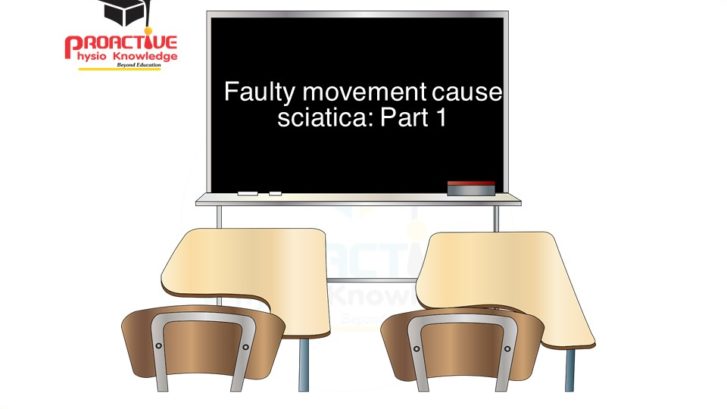Faulty movement cause Sciatica : Part 1
Sciatica is often described as mild to intense low back pain that travels into the left or right leg. Radiculopathy can occur when a spinal nerve root is compressed (nerve compression) such as from a low back disc rupture (lumbar herniated disc) or bone spur (osteophyte) in the lumbar spine prior to it joining the sciatic nerve.

What Causes Sciatic Nerve Compression?
- Herniated disc
- Lumbar spinal stenosis
- Spondylolisthesis
- Piriformis syndrome
- Trauma
- Spinal tumor
Piriformis affection:

Spasm of the piriformis muscle and sacral dysfunction (eg, torsion) cause stress on the sacrotuberous ligament. This stress may lead to compression of the pudendal nerves or increased mechanical stress on the innominate bones, potentially causing groin and pelvic pain.Compression of the fibular branch of the sciatic nerve often causes pain or paresthesia in the posterior thigh.
In most cases of piriformis syndrome, the sacrum is anteriorly rotated toward the ipsilateral side on a contralateral oblique axis, resulting in compensatory rotation of the lower lumbar vertebrae in the opposite direction. By changing axis of rotation sciatic nerve trapped between the muscle.
Faulty movement perspective Spondylolisthesis:
The primary role of the iliolumbar ligaments is to prevent excessive lumbar sidebending, However, these ligaments can contribute to sciatic nerve entrapment when injured. A While lifting heavy object ( bending and twisting maneuver), may strain the iliolumbar ligaments and multifidus (Image 3). As the ligament get injured, gradually it become weak, they lose the ability to prevent the fifth lumbar vertebra from shifting forward on the sacrum which may cause contralateral narrowing of the intervertebral foramen, facet arthrosis and possible sciatic nerve entrapment. This means lumbar spine become unstable during its motion. Obliques, iliopsoas,posterior subsystem gets affected. patient develops pain during extension and rotation movement.

In extreme cases, slippage of the fourth or fifth lumbar vertebra may result in spondylolisthesis, when person is in severe pain, the obliques, iliopsoas , transvers abdominus fails to hold the spine in neutral zone. HIp and pelvic works as a single unit. Hip extension decrese due to anterior rotation of pelvic where the pars interarticularis cracks from excessive pressure, allowing sciatic nerve entrapment on one or both sides (Image 3).
In the initial phase, the patient may or may not experience symptoms depending on the brain’s perception of the degree of threat. However, prolonged nerve root compression may begin to obstruct axoplasmic transport of proteins and other cell parts to and from the neuron’s cell body. Clinically, this breakdown of nerve conduction called “double crush syndrome.” This term refers to scenarios where compressed axons at one site cause the nerve to become especially susceptible to damage at another site, such as under the piriformis muscle.
The brain may try to stabilize the lumbosacral joint by layering the area with protective multifidus muscle spasm, but it does little good to try to release hypertonic spasm in these spinal groove stabilizers until the pelvic alignment problem is corrected. Fortunately, there are many ways manual therapists can successfully assess and correct iliosacral alignment.
Stay tune with us for second part….
References:
Chaitow L. Soft Tissue Manipulation: A Practitioner’s Guide to the Diagnosis and Treatment of Soft-Tissue Dysfunction and Reflex Activity. 3rd ed. Rochester, Vt: Healing Arts Press;1988 .
Steiner C, Staubs C, Ganon M, Buhlinger C. Piriformis syndrome: pathogenesis, diagnosis, and treatment. J Am Osteopath Assoc. 1987;87:318-323
P. Hanson and B. Sonesson, “The Anatomy of the Iliolumbar Ligament,” Archives of Physical Medicine & Rehabilitation 75, no. 11 (November 1994): 1,245–46
A. R. Upton and A. J. McComas, “The Double Crush in Nerve Entrapment Syndromes,” Lancet 2, no. 7,825 (August 1973): 359–62.
Pic coutsey : google




Leave a Reply
Want to join the discussion?Feel free to contribute!